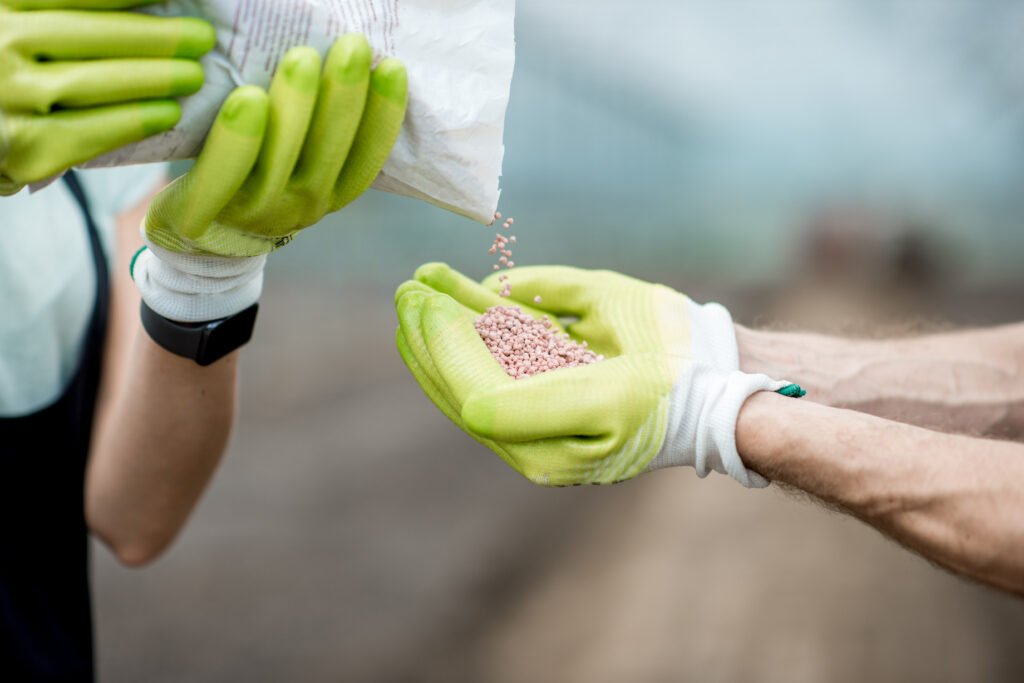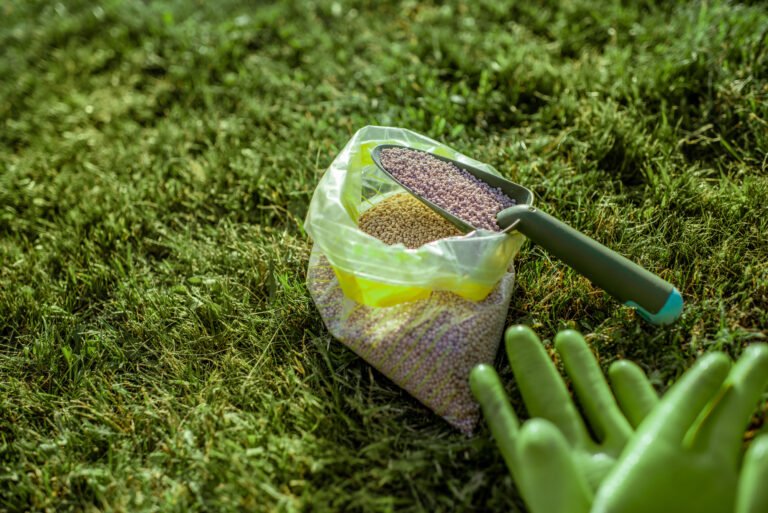Understanding Southern California’s Lawn Types
Fertilizing your lawn in Southern California isn’t just about keeping the grass green — it’s about timing, climate, and water-wise practices. Our region’s mild winters, hot summers, and strict watering restrictions mean that a one-size-fits-all approach doesn’t work. Fertilizing too early or too late can waste product, stress your grass, and even lead to disease.
By fertilizing at the right times of year, you can help your lawn handle drought, heat, and foot traffic while maintaining strong roots and a lush, healthy appearance. Most Southern California lawns need fertilization three to four times per year, but the exact timing depends on whether you have a warm-season or cool-season grass.
Understanding Southern California’s Lawn Types

Not all lawns in Southern California are the same, and the type of grass you have makes a big difference in when and how often to fertilize. Knowing whether your lawn is a warm-season or cool-season grass helps you create a fertilization schedule that keeps it green without wasting product.
Warm-Season Grasses
Warm-season grasses thrive in the heat of Southern California summers. Common types include Bermuda, St. Augustine, Zoysia, and Kikuyu. These grasses grow most actively from late spring through early fall, which makes that window the best time for fertilization.
Cool-Season Grasses
Cool-season grasses, like fescue and ryegrass, are less common but still found in some Southern California lawns, especially in shaded yards. They grow most vigorously in spring and fall when temperatures are mild, so fertilization is best timed around those seasons.
Not Sure Which One You Have?
If your lawn greens up strongly in summer heat, it’s likely a warm-season grass. If it struggles in summer but looks vibrant in spring and fall, you probably have a cool-season lawn. Homeowners can also check the texture: warm-season grasses tend to be coarser and spread by runners, while cool-season grasses grow in clumps and feel finer.
The Best Time to Fertilize Your Lawn in Southern California

Timing your fertilizer applications to match Southern California’s seasons ensures your lawn gets nutrients when it can actually use them. Here’s a season-by-season breakdown:
Spring (March–May)
- Active growth period for both warm- and cool-season grasses
- Ideal time for the first application of the year
- Pair fertilization with irrigation system checks after winter
Summer (June–August)
- Warm-season grasses thrive and benefit from mid-summer feeding
- Avoid heavy fertilization during extreme heat to prevent stress
- Use slow-release products to reduce the risk of nitrogen burn
Fall (September–November)
- The most important feeding season of the year
- Builds root strength for winter and supports overseeding
- Perfect time to fertilize cool-season lawns in particular
Winter (December–February)
- Minimal growth for warm-season grasses — they often go dormant
- Light feeding may benefit cool-season lawns in mild weather
- Better to focus on soil testing and prep for spring
How Much Fertilizer Should You Use?
Applying the right amount of fertilizer is just as important as timing. Too little won’t deliver results, while too much can burn your lawn or pollute local waterways.
General Guidelines
- Most Southern California lawns need about 3–4 pounds of nitrogen per 1,000 sq. ft. per year
- Split this into multiple applications rather than one heavy feeding
- Use slow-release products to deliver nutrients steadily over time
Warm-Season Grasses
- Apply lighter, more frequent feedings between late spring and early fall
- Stick to 0.5–1 pound of nitrogen per 1,000 sq. ft. per application
- Avoid fertilizing during peak summer heat waves
Cool-Season Grasses
- Fertilize mainly in spring and fall when these grasses are actively growing
- Use 0.75–1 pound of nitrogen per 1,000 sq. ft. per application
- Limit winter applications to mild conditions only
Tips for Accuracy
- Always measure your lawn area before calculating amounts
- Check the fertilizer bag for the nitrogen percentage (the first number on the label)
- Use a spreader for even coverage and avoid streaking
Signs Your Lawn Needs Fertilizer

Even with a seasonal schedule, your lawn may show signs that it needs extra nutrients. Paying attention to these cues helps you fertilize at the right time.
Yellowing Grass
- Uniform yellow or pale green color often signals nitrogen deficiency
- Usually starts in older grass blades first
Slow or Uneven Growth
- Lawn doesn’t bounce back quickly after mowing
- Some patches grow slower than others, leaving the yard looking uneven
Thinning or Bare Spots
- Areas of weak growth that don’t fill in on their own
- Can be worsened by foot traffic or poor soil health
More Weeds Than Grass
- Fertilizer helps grass outcompete weeds
- If weeds spread faster than turf, your lawn may lack nutrients
Seasonal Stress
- Heat, drought, and heavy use all increase nutrient demand
- Lawns may need extra support after summer heat or winter dormancy
Water-Wise Fertilization in Southern California
With strict water restrictions and frequent droughts, Southern California lawns need fertilization strategies that protect both your grass and water supply.
Pair Fertilization With Irrigation
- Water deeply right after applying fertilizer to help nutrients soak in
- Adjust sprinklers to avoid runoff onto sidewalks and driveways
- Morning watering is best to reduce evaporation losses
Choose the Right Fertilizer
- Look for slow-release or organic options that minimize leaching
- Avoid heavy doses of quick-release nitrogen in hot weather
- Consider balanced blends with micronutrients to support soil health
Adjust for Drought Conditions
- Fertilize less often during extended drought to avoid stressing turf
- Skip fertilization if your lawn is dormant from lack of water
- Focus on soil building with compost or mulch when irrigation is limited
Smart Irrigation Upgrades
- Install drip systems or smart controllers to improve water efficiency
- Check and repair irrigation systems before each season
- Combine watering schedules with fertilization for the best results
Expert Tips for Fertilizing Southern California Lawns

Beyond timing and amounts, these expert tips can help you get the most out of every application.
Test Your Soil First
- A soil test shows nutrient levels and pH so you don’t over-apply
- Testing every 2–3 years ensures your fertilization plan stays accurate
Mow and Water Correctly
- Mow regularly, but never cut more than one-third of the grass height
- Water deeply but infrequently to encourage deep root growth
Pair Fertilization With Aeration
- Aerating in spring or fall helps nutrients reach the roots
- Especially helpful for compacted soils or high-traffic lawns
Watch the Weather
- Avoid fertilizing right before heavy rain to prevent runoff
- Apply on mild days instead of extreme heat for best absorption
Don’t Forget Seasonal Cleanups
- Remove leaves, thatch, and debris before fertilizing
- A clean lawn ensures even coverage and better nutrient uptake
FAQs About Fertilizing Lawns in Southern California
How often should I fertilize my lawn?
Most Southern California lawns need fertilization 3–4 times per year, with timing based on whether you have warm-season or cool-season grass.
Should I fertilize before or after mowing?
It’s best to mow first, then fertilize. This ensures the fertilizer reaches the soil and isn’t trapped in long grass blades.
Do I need to water after fertilizing?
Yes. Watering right after application helps nutrients soak into the soil and prevents burning the grass.
Can I fertilize during a drought?
Only if your lawn is being watered. If it’s dormant due to restrictions, hold off until irrigation resumes or rains return.
What type of fertilizer is best for Southern California lawns?
Slow-release fertilizers with balanced nutrients are best. Choose formulas suited to your grass type and local soil conditions.
Final Thoughts on Fertilizing Lawns in Southern California
Fertilizing your lawn in Southern California comes down to timing, grass type, and water-wise practices. By following a seasonal schedule, using the right products, and adjusting for drought conditions, you’ll give your lawn the nutrients it needs to stay healthy and green year-round.
If you’re unsure about when or how to fertilize, or simply want reliable results without the guesswork, professional lawn care can make all the difference.
Call Aragon for Expert Lawn Care in Orange County
Aragon has been helping homeowners and businesses across Orange County since 2005. As a family-owned company, we treat every lawn like our own — with great communication, dependable service, and results that last.
Ready for a healthier lawn? Call us today at 949-903-0234 or request a free quote online.

